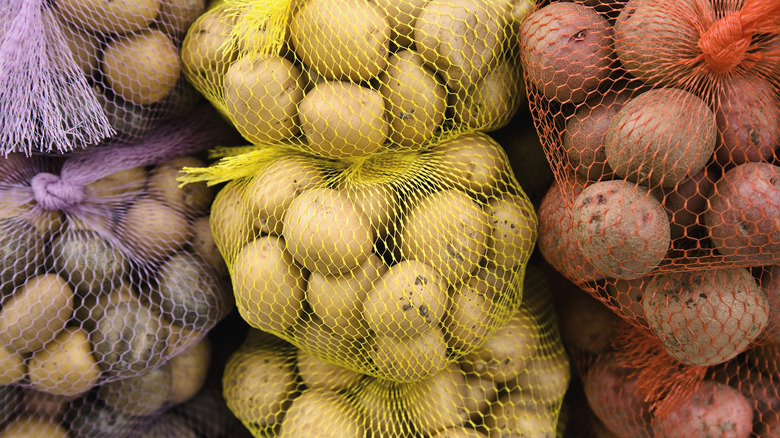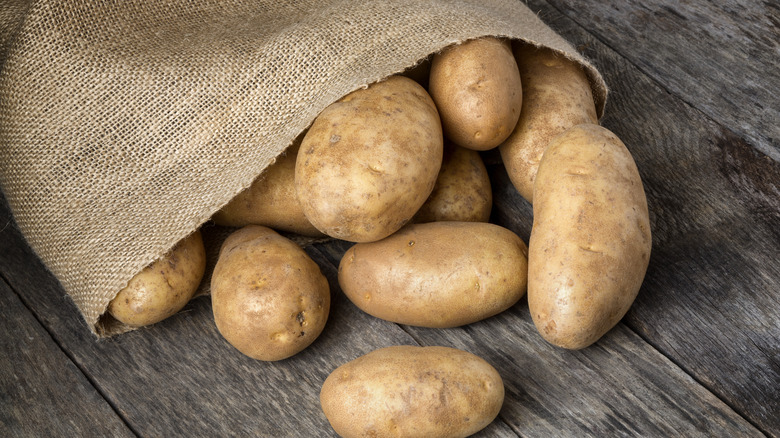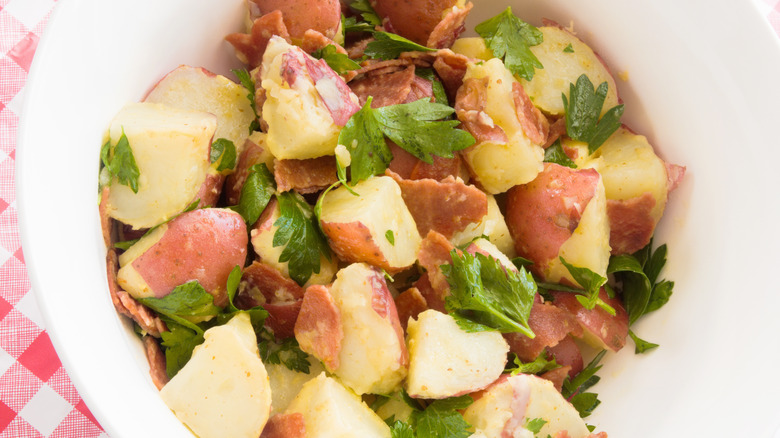Cheat Sheet: Which Potatoes Are Waxy Vs. Starchy
It's easy to take the humble potato for granted, especially when the United States Department of Agriculture calls it the most commonly consumed vegetable in the country. Given all that tater love, it comes as little surprise that "a potato is not just a potato" with more than 4,000 native potato varieties existing across the globe.
Though categorizing potatoes can be broadly subjective, the classification gets even more narrow when considering which kinds of potatoes to use for a particular dish. Whether the desired end result is mashed, fried, baked, scalloped, roasted, or rolled into casseroles, gratins, or soups, you'll be reaching for either "starchy" or "waxed" potatoes. Almost every type available for your stovetop, oven, air fryer, or grill will fall into one of those two categories.
Though a third, more nebulous "all-purpose" group exists, it basically consists of a single potato type, the Yukon Gold. It stands alone as a "medium" cross between a starchy white spud from North America and a waxy yellow one from South America. To make things easier, here's a cheat sheet on identifying starchy and waxy tubers and when to choose one over the other for your meals.
Starchy potatoes are best for mashed potatoes and frying
When potatoes crashed the Colonial party in 1621 by way of two cedar chests landing in Jamestown, few would have imagined the billions more to follow. Now leading the potato pack are brown Russets, preferred by about 55% of consumers in America, per Statista. It's also the most popular spud in the starchy category.
Defined by their high starch and low moisture content, starchy potatoes, sometimes known as "floury," harbor a white, flaky, and dry inner flesh with varying skin colors. By far, the most prevalent starchy potato is the brown Russet, joined in the category by sweet potatoes, King Edward, and others.
The starchy flesh breaks apart more easily than waxy varieties, making these ideal for fluffy, soft mashed potatoes. They also work well in classic baked potatoes because the tender insides and low-moisture dryness soak up any goodness you add, such as butter, sour cream, dressing, or cheesy sauces.
Another less-recognized benefit of starchy potatoes is that they dissolve into a mealy mess when boiled, making them useful for thickening pureed soups without the need for milk, cream, or flour. They're also excellent for roasting and frying since the starch aids in achieving that crispy exterior we all crave. Think french fries, crispy hash browns, crunchy homemade potato chips, and roasted or air-fried potato wedges.
Waxy potatoes stand firm and can be used in potato salad and casseroles
With notably contrasting characteristics to starchy potatoes, those falling in the waxy family have comparatively low starch and high moisture content. They stand firm when the heat is on, making them heroes of potato salad, curry, stew, and casserole devotees. Rather than collapsing under pressure, they maintain their shape and texture within the finished dish.
Well-known waxy potatoes include Red Bliss, Red Adirondack, French fingerlings, and baby potatoes. Another popular type in this category is new potatoes, which get harvested early and have a generally smaller, rounder appearance than ones that have matured longer in the fields. The outer skins of new potatoes are much thinner and fragile, typically eliminating the need to peel them before cooking and consuming.
Potatoes, in general, harbor some health-enhancing attributes, including high-fiber skins and inherent nutrients such as potassium and vitamins C and B6, explains WebMD. But the starchy carbohydrates in a potato break down quickly and can cause abrupt rises in blood sugar. Because of this, consuming waxy potato varieties with lower starch levels and lower glycemic index (GI) can be advantageous for keeping blood sugar under control.


